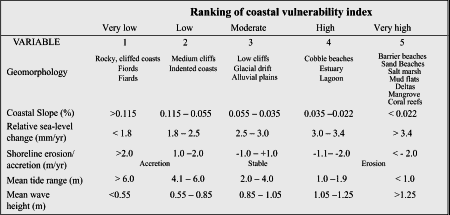 |
|
|
||||||||||||||||
|
| |
Table 1. Ranking of coastal vulnerability index variables for the U.S. Gulf of Mexico. | |
Once each section of coastline is assigned a risk value based on each specific data variable, the coastal vulnerability index is calculated as the square root of the geometric mean, or the square root of the product of the ranked variables divided by the total number of variables as
where,
- a = geomorphology
- b = coastal slope
- c = relative sea-level rise rate
- d = shoreline erosion/accretion rate
- e = mean tide range
- f = mean wave height
The C.V.I. values reported here apply specifically to the U.S. Gulf of Mexico coast, but are also comparable to the values for the U.S. Atlantic coast since the data ranges for the Gulf of Mexico are categorized using overall values for both coasts. Absolute C.V.I. values given for the Pacific coast, however, (e.g., Thieler and Hammar-Klose, 2000) are not directly comparable to the data presented here. We feel this approach best describes and highlights the vulnerability for each of the different continental margin types that make up the U.S. coast.
| Previous Page | Contents | Back to Top | Title Page |
|
Next Page |
| Introduction | Risk Variables |
Data Ranking |
C.V.I. | Results | Discussion | Summary | References |
| [an error occurred while processing this directive] |
